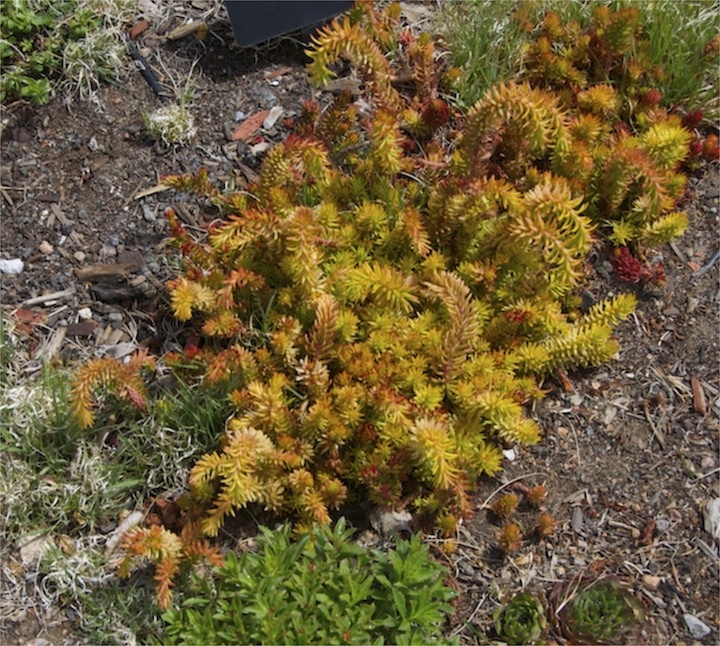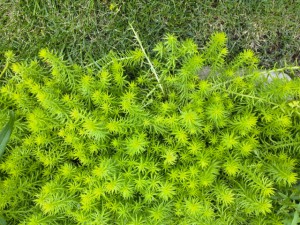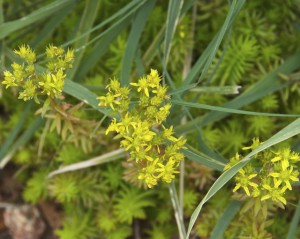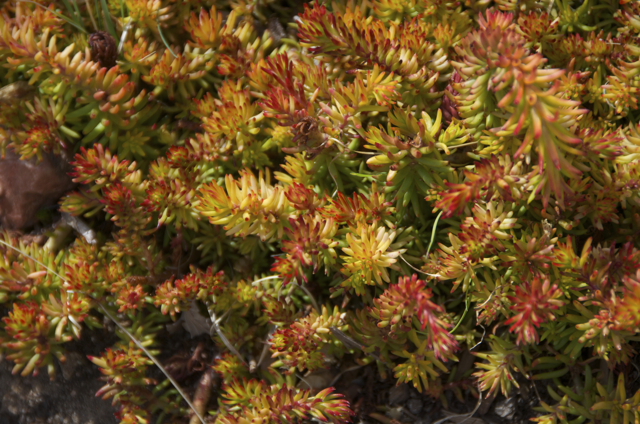Scientific name: Sedum rupestre ‘Angelina’
Synonym: Sedum reflexum ‘Angelina’
Common names: Sedum ‘Angelina’, Stonecrop, Rocky Stonecrop, Love Links
Plant Family: Crassulaceae (Stonecrop)
Article and photos by Janice Tucker
“Color it autumn” is the best way to describe the foliage of the Sedum rupestre ‘Angelina’ this time of the year. It is attractive, hardy, drought tolerant, low maintenance, resistant to harmful insects and diseases, woos pollinators and holds no attraction to deer. What’s not to like?

Sedum rupestre ‘Angelina’ fall foliage (Photo by Janice Tucker)

Sedum rupestre ‘Angelina’ spring summer (Photo by Bernie Minard)
A member of the Crassulaceae family, the Sedum genus of 600 species and numerous cultivars are flowering plants with succulent leaves. Native to Europe and/or North and South Asia, they have happily naturalized in North America and New Zealand. Species range from ground covers to shrubs.
The cultivar Sedum ‘Angelina’ is a perennial, mat-forming, fast growing groundcover. It reaches 4 to 6 inches in height and spreads to 24 inches wide. The foliage is non-prickly, and bristle-shaped. The leaves, which are chartreuse in spring and summer, turn a beautiful autumnal yellow, gold and red during the fall. The ‘Angelina’ is a cultivar that often has reddish-brown tips even in the summer. (Source 1) In June and August, yellow, star-shaped flower clusters rise above the plant on 6 to 8 inch stems. (Source 2). The colorful foliage often outshines the flowers that tend to blend in with the leaves. However, the nectar-laden flowers earn their keep by attracting bees and butterflies as well as other pollinators. They are particularly alluring to hoverflies, whose larvae nosh on aphids, another good reason to have this plant in the garden.

Sedum rupestre ‘Angelina’ flowers (Photo by Janice Tucker)
Sedum ‘Angelina’ should be planted in neutral pH soil in full sun. The more sun exposure, the more colorful the foliage. Water requirements are low to medium. It can tolerate some drought conditions but the plant is more attractive when it receives at least a moderate amount of water. It is cold hardy to <0° F and withstands a range of temperatures, making it very adaptable to the Santa Fe climate. Sedums can attribute some of their hardiness to the ability of closing their pores in hot sunlight and opening them at night to take in carbon dioxide and expel oxygen. (Source 4) This plant is low maintenance, requiring only some dead heading after flowering in order to maintain an attractive appearance. Pruning can be done anytime, but it is not necessary for the health of the plant.
The genus Sedum is defined as “to sit, or sedentary”. The species rupestre means rock loving (Source 5). Several Sedum species prefer rocky habitats, and often appear to sprout directly from rocks. The common name Stonecrop applies to the genus as well as many of the Sedum species.
Christian Kress, an Austrian nurseryman discovered the Sedum ‘Angelina’ while visiting a private garden in Croatia and named the cultivar for the garden owner’s wife. (Source 2)
Sedums have been used as roof grasses because of their hardy nature and low maintenance. Folklore claims that love spells using sedums sometimes known as “Love Links” enhance love and marriage. (Source 4)
Visit the Santa Fe Botanical Garden at Museum Hill to see Sedum ‘Angelina’ as well as companion plants that cohabit with it. You can’t miss it. It’s the color of autumn.

Sedum rupestre ‘Angelina’ close up (Photo by Janice Tucker)
Source 1: Sedum rupestre ‘Angelina’, Missouri Botanical Garden, www.missouribotanicalgarden.org
Source 2: Sedum rupestre ‘Angelina’, San Marcos Growers, www.smgrowers.com
Source 3: Sedum rupestre ’Angelina’, North Creek Nurseries, www.northcreeknurseries.com
Source 4: Sedum reflexum (rupestre), Seedaholic.com, www.seedaholic.com
Source 5: Stearn, William T., Stearn’s Dictionary of Plant Names for Gardeners, A Handbook on the Origin and Meaning of the Botanical Names of some Cultivated Plants, Cassell Wellington House, 125 Strand, London WC2R OBB, 1996
Thanks to Helen Woody for proofreading this article.


